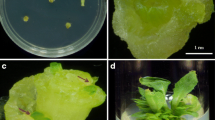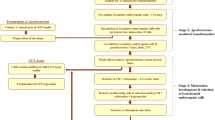Abstract
Plant transformation has emerged as an important tool to integrate foreign genes in the plant genome to modify the plants for desired traits. Though many techniques of plant transformation are available; getting single copy transgenic events and cost associated remains a big challenge. Thus Agrobacterium-mediated transformation remains the method of choice due to multiple advantages. In the present work a tissue culture free protocol of Agrobacterium-mediated transformation was optimized in safflower, an oil seed crop recalcitrant to transformation. As a proof of concept we selected pCAMBIA2300 gene cassette containing Arabidopsis specific delta 15 desaturase (FAD3) downstream to truncated seed specific promoter beta-conglycinin and optimized tissue culture free protocol of Agrobacterium-mediated transformation using embryos as explants. Addition of silwet L-77, sonication treatment, vacuum infiltration in infection medium and use of paper wicks in co-cultivation period increased the transformation efficiency to 19.3%. Further, success in transformation was confirmed via product accumulation in 21 independent transgenic events wherein oil in transformed seeds showed significant accumulation of alpha-linolenic acid (ALA; 18:3; n3) which is generated from linoleic acid (LA; 18:2; n3) in a FAD3 catalyzed reaction. The present protocol can be utilized to produce transgenic safflower with different desired characters.



Similar content being viewed by others
Abbreviations
- ALA:
-
Alpha linolenic acid
- BAP:
-
6-Benzylaminopurine
- βCG:
-
Beta- conglycinin
- FAD:
-
Fatty acid desaturase
- GLA:
-
Gamma linolenic acid
- IBA:
-
Indole butyric acid
- LA:
-
Linoleic acid
References
Amoah BK, Wu H, Sparks C, Jones HD (2001) Factors influencing Agrobacterium-mediated transient expression of uid A in wheat inflorescence tissue. J Exp Bot 52:1135–1142
Bakshi S, Sadhukhan A, Mishra S, Sahoo L (2011) Improved Agrobacterium- mediated transformation of cowpea via sonication and vacuum infiltration. Plant Cell Rep 30:2281–2292
Bechtold N, Pelletier G (1998) In planta Agrobacterium-mediated transformation of adult Arabidopsis thaliana plants by vacuum infiltration. Methods Mol Biol 82:259–266
Belide S, Hac L, Singh SP, Green AG, Wood CC (2011) Agrobacterium-mediated transformation of safflower and the efficient recovery of transgenic plants via grafting. Plant Methods 7:12
Bradford MM (1976) A rapid and sensitive method for the quantitation of microgram quantities of protein utilizing the principle of protein-dye binding. Anal Biochem 72:248–254
Canche-Moo RLR, Ku-Gonzalez A, Burgeff C, Loyola-Vargas VM, Rodrì-guez-Zapata LC, Castano E (2006) Genetic transformation of Coffea canephora by vacuum infiltration. Plant Cell Tissue Organ Cult 84:373–377
Charity JA, Holland L, Donaldson SS, Grace L, Walter C (2002) Agrobacterium-mediated transformation of Pinus radiata organogenic tissue using vacuum infiltration. Plant Cell Tissue Organ Cult 70:51–60
Dajue L, Mündel HH (1996) Safflower (Carthamus tinctorius L.) In: Promoting the conservation and use of underutilized and neglected crops.7. Institute of Plant Genetics and Crop Plant Research, Gatersleben/International Plant Genetic Resources Institute, Rome Italy
Dong J, Teng W, Buchholz WG, Hall TC (1996) Agrobacterium-mediated transformation of Javanica rice. Mol Breed 2:267–276
Finer JJ, Larkin KM (2008) Genetic transformation of soybean using particle bombardment and SAAT approaches. In: Kirti P (ed) Handbook of new technologies for genetic improvement of legumes. CRC Press, Boca Raton, pp 103–123
Guan LL, Wu W, Hu B, Li D, Chen JW, Hou K, Wang L (2014) Developmental and growth temperature regulation of omega-3 fatty acid desaturase genes in safflower (Carthamus tinctorius L.). Genet Mol Res 13:6623–6637
Hardegger M, Sturm A (1998) Transformation and regeneration of carrot (Daucus carota L.). Mol Breed 4:119–127
Mandal AK, Gupta DS (2001) Direct shoot organogenesis and plant regeneration in safflower. In vitro Cell Dev Biol 37:50–54
Mariashibu TS, Subramanyam K, Arun M, Mayavan S, Rajesh M, Theboral J, Manick- avasagam M, Ganapathi A (2013) Vacuum infiltration enhances the Agrobacterium-mediated genetic transformation in Indian soybean cultivars. Acta Physiol Plant 35:41–54
Nanasato Y, Konagaya K, Okuzaki A, Tsuda M, Tabei Y (2011) Agrobacterium-mediated transformation of kabocha squash (Cucurbita moschata Duch) induced by wounding with aluminum borate whiskers. Plant Cell Rep 30:1455–1464
Nanasato Y, Konagaya K, Okuzaki A, Tsuda M, Tabei Y (2013) Improvement of Agrobacterium-mediated transformation of cucumber (Cucumis sativus L.) by combination of vacuum infiltration and co-cultivation on filter paper wicks. Plant Biotechnol Rep 7:267–276
Nanasato Y, Kido M, Kato A, Ueda T, Suharsono S, Widyastuti U, Tsujimoto H, Akashi K (2015) Efficient genetic transformation of Jatropha curcas L. by means of vacuum infiltration combined with filter paper wicks. In Vitro Cell Dev Biol 51:399–406
Nikam TD, Shitole MG (1999) In vitro culture of Safflower L. cv. Bhima: initiation, growth optimization and organogenesis. Plant Cell Tissue Organ Cult 55:15–22
Orlikowska TK, Dyer WE (1993) In vitro regeneration and multiplication of safflower (Carthamus tinctorius L.). Plant Sci 93:151–157
Ozawa K (2009) Establishment of a high efficiency Agrobacterium-mediated transformation system of rice (Oryza sativa L.). Plant Sci 176:522–527
Radhika K, Sujatha M, Rao NT (2006) Thidiazuran stimulates adventitious shoot regeneration in different safflower explants. Biol Plant 50:174–179
Rohini VK, Rao SK (2000) Embryo transformation, a practical approach for realizing transgenic plants of safflower (Carthamus tinctorius L.). Ann Bot 86:1043–1049
Soxhlet F (1879) Die gewichtsanalytische Bestimmung des Milchfettes. Dingler’s Polytech J 232:461–465
Sujatha M, Kumar DV (2007) In vitro bud regeneration of Carthamus tinctorius and wild Carthamus species from leaf explants and axillary buds. Biol Plant 51:782–786
Tague BW, Mantis J (2006) In planta Agrobacterium-mediated transformation by vacuum infiltration. Methods Mol Biol 323:215–223
Trick HN, Finer JJ (1997) SAAT: sonication-assisted Agrobacterium-mediated transformation. Trans Res 6:329–337
Zhang X, Li M, Wei D, Xing L (2008) Identification and characterization of a novel yeast ω3-fatty acid desaturase acting on long-chain n-6 fatty acid substrates from Pichia pastoris. Yeast 25:21–27
Acknowledgements
Authors are thankful to Department of Biotechnology [DBT; Ref No. (BT/PR4077/AGR/2/832/2011)], India, for providing financial assistance. Arti Rani is thankful to the Department of Science and Technology (DST) for providing fellowship under women scientist [WOS (A); Ref no. SR/WOS-A/LS-580/2013 dated 1.8.2014]. Technical help provided by Dr. Karunakara Alageri Chandrashekhara for GC analysis of the samples and by Mrs Kamla for maintaining the plants in green house is highly acknowledged. Authors are thankful to Dr. Kshitish Acharya, Shodhaka Life Sciences Pvt. Ltd. (www.shodhaka.com), Bengaluru for statistical analysis of the data.
Author information
Authors and Affiliations
Contributions
Dr Arti Rani designed the experiments, performed few experiments and wrote the manuscript. Asha Panwar and Manjary Sathe optimized various parameters of Agrobacterium-mediated in planta transformation. Molecular work such as RT-PCR to screen transformed plants was done by Arti Rani and Asha Panwar. Oil extraction from the transformed seeds for GC analysis was done by Manjary Sathe. Dr Anil Kush did overall supervision of the project work.
Corresponding author
Ethics declarations
Conflict of interest
The authors declare that they have no conflict of interest.
Electronic supplementary material
Below is the link to the electronic supplementary material.
Rights and permissions
About this article
Cite this article
Rani, A., Panwar, A., Sathe, M. et al. A modified in planta method of Agrobacterium-mediated transformation enhances the transformation efficiency in safflower (Carthamus tinctorius L.). J. Plant Biochem. Biotechnol. 27, 272–283 (2018). https://doi.org/10.1007/s13562-017-0437-3
Received:
Accepted:
Published:
Issue Date:
DOI: https://doi.org/10.1007/s13562-017-0437-3




